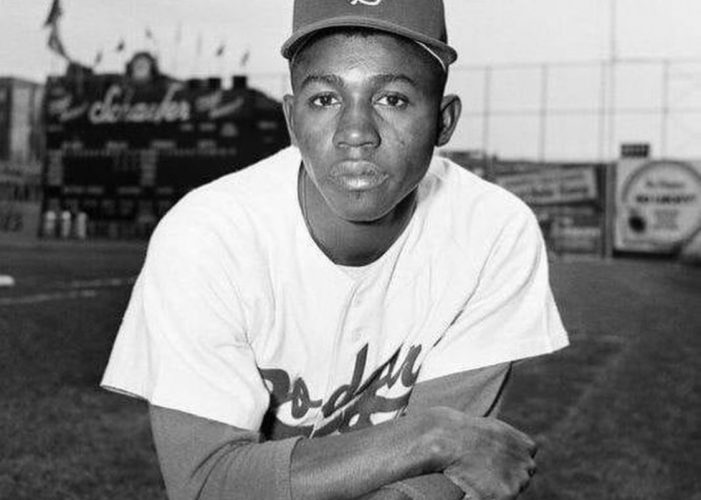Jim Gilliam
Positions: Second Baseman, Third Baseman and Leftfielder
Bats: Both • Throws: Right
5-10, 175lb (178cm, 79kg)
Born: October 17, 1928 in Nashville, TN us
Died: October 8, 1978 in Inglewood, CA
Buried: Inglewood Park Cemetery, Inglewood, CA
High School: Pearl HS (Nashville, TN)
Debut: 1946 (10,019th in major league history)
AL/NL Debut: April 14, 1953
vs. PIT 5 AB, 1 H, 0 HR, 0 RBI, 0 SB
Last Game: September 30, 1966
vs. PHI 1 AB, 0 H, 0 HR, 0 RBI, 0 SB
Full Name: James William Gilliam
Nicknames: Junior
View Player Info from the B-R Bullpen
View Player Bio from the SABR BioProject
Nine Players Who Debuted in 1953
Al Kaline
Ernie Banks
Junior Gilliam
Roy Face
Don Larsen
Johnny Podres
Bob Buhl
Bobo Holloman
Bill Bruton
Notable Events and Chronology for Jim Gilliam Career
Biography
Nicknamed Junior as the youngest member of the Baltimore Elite Giants, Gilliam and shortstop Pee Wee Butts formed one of the great double play combos in Negro National League history during the 1940s. The Tennessean was named to the Negro NL East All-Star team three straight years (1948-50). Finally signed by the Dodgers and sent to Montreal, Gilliam twice led the International League in runs scored (117 in 1951, and 111 in 1952). He also led in fielding in 1952, convincing the Dodgers to shuttle Jackie Robinson between second base and third base and Gilliam between the infield and outfield to get him into the lineup.
As Dodger second baseman in 1953, Gilliam set a league rookie record with 100 walks, led the NL with 17 triples, scored a career-high 125 runs, and was named Rookie of the Year. He switch-hit homers in the 1953 World Series. In 1956, 1957, and 1959, Gilliam finished second to Willie Mays in stolen bases. He scored at least 100 runs in each of his first four seasons, and hit .300 for the only time in 1956.
Gilliam became a fan favorite in the Dodgers’ first season in Los Angeles (1958) by leading the club in hits, doubles, steals, walks, and fielding. Switched to third base, he homered in the second 1959 All-Star Game. He retired after 1964 to become Los Angeles’s third base coach, but he came out of retirement in 1965 to hit .280 for the World Champion Dodgers and join first baseman Wes Parker, second baseman Jim Lefebvre, and shortstop Maury Wills in the major leagues’ first switch-hitting infield. He retired again and then returned once more to help the Dodgers repeat as NL champions in 1966. Gilliam coached until his sudden death of a brain hemorrhage just before the start of the 1978 World Series. The Dodgers retired his uniform number 19.
Factoids, Quotes, Milestones and Odd Facts
Played For
Brooklyn Dodgers (1953-1957)
Los Angeles Dodgers (1958-1966)
Linked: With the Dodgers in the mid-1960s, Gilliam and teammates Wes Parker, Maury Wills, and Jim Lefebvre formed baseball’s first all-switch-hitting infield.
Best Season, 1953
NL Rookie of the Year voting: Jim Gilliam (11 votes), Harvey Haddix (4), Ray Jablonski (3), Bill Bruton (2), Rip Repulski (2), Fred Baczewski (1), Jim Greengrass (1)
Awards and Honors
1953 NL Rookie of the Year
Post-Season Appearances
1953 World Series
1955 World Series
1956 World Series
1959 World Series
1963 World Series
1965 World Series
1966 World Series
Factoid
Jim Gilliam scored at least 100 runs in each of his first four big league seasons.
Where He Played: Second base (1,046 games), third (761), outfield (222, mostly in left).
Factoid
Over his 14-year career, Jim Gilliam averaged 86 walks and just 34 strikeouts per season.
All-Star Selections
1956 NL
1959 NL
Replaced
Jackie Robinson, who became one of his best friends on the team.
Replaced By
Gilliam retired twice to become the Dodgers third base coach, but jumped back into the lineup when the season started and contributed greatly. Finally, when he was done, he was replaced by a few utlity guys who filled his 200-350 at-bats that were split between third, second, and the outfield.
Best Strength as a Player
Ability to draw walks.
Largest Weakness as a Player
He showed some bad judgment on the basepaths, but that’s nitpicking.
Other Resources & Links





